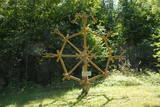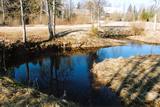| Nr | Nosaukums | Apraksts |
|---|---|---|
|
Bērziņu mājās cep brīnumgardu kviešu un rudzu maizi pēc senām dzimtas receptēm. Garšu un smaržu maizei piedod īpašā krāsns, kurai ir vairāk nekā 70 gadi. Maizi iespējams pasūtīt vai, iepriekš piesakoties, izveidot un izcept paši savu kukulīti. |
||
|
Priekules luterāņu baznīca celta baronu laikos ap 1680. gadu. 1792. gadā tā piedzīvojusi jaunu pārbūvi un ieguvusi tagadējo izskatu. No 2005. gada 6. augusta visiem interesentiem ir pieejams baznīcas skatu tornis, no kura savulaik savu vēsturisko lidojumu ir sācis leģendārais Priekules Ikars. Baznīcas tornī Sakrālā tūrisma projekta ietvaros ir ierīkotas savdabīgas kāpnes, par kurām uzkāpjot torņa smailē kaut nedaudz iejutīsieties Ikara lomā un aplūkosiet pilsētu no augšas. |
||
|
Folkloras taka "Jāņkalni" iepazīstina ar mūsu senču rakstiem, zīmēm un dievībām, kas ir mūsu folkloras mantojums. Folkloras takas (garums: apm. 1,5 km vai 2 stundas) mērķis ir arī iepazīstināšana ar senlatviešu ieražām, folkloru, kā arī tautu dainu izprašana. Piedāvā iziet Latvijas karti - labirintu ar 19 etnogrāfiskajiem novadiem. Gids Jums sniegs izsmeļošu stāstījumu un atbildes uz interesējošiem jautājumiem.
|
||
|
Viens no lielākajiem Igaunijas karsta laukiem. Tā interesantākais dabas veidojums ir unikālā Raganu aka, pa kuru pavasara palos (ne katru gadu un salīdzinoši īsu laika brīdi!) izplūst pazemes upes ūdeņi, veidojot neparasti spēcīgu karsta avotu, kura izvirstais ūdens daudzums var sasniegt 100 l/s.
|
||
|
Saimniecība piedāvā apskatei zirgus, ponijus, trušus, Bramas šķirnes vistas un cāļus. Bērniem tiek piedāvātas izjādes ar mazo poniju Xavier gan mugurā (bērna svars līdz 35 kg), gan mazos ratos. |
||
|
Talsus tēlaini sauc par deviņu pakalnu pilsētu, tādēļ vērts izstaigāt šo skaisto pilsētu ar kājām. Skaistākie skati pavērsies no Talsu pilskalna (uz Talsu ezeru, Ķēniņkalnu), Sauleskalna (Talsu ezeru, pilskalnu, Ķēniņkalnu) un Ķēniņkalna pastaigu takām (uz Talsu ezeru, pilskalnu un pilsētas vēsturisko centru).
|
||
|
Tornis atrodas Vasenieku purva rietumdaļā, kuras apskates nolūkā izveidota interesanta un ar informatīviem stendiem un laipām labiekārtota dabas taka. No torņa vērojamas ļoti savdabīgas purva ainavas (pārskatāms viss purvs). Mitrā laikā noderēs piemēroti apavi! |
||
|
Kopš dižākā – Kalnasikšņu ozola bojāejas Kvēpenes dižozols ir kļuvis par varenāko Gaujas nacionālā parka koku. Tā apkārtmērs ir 6,1 m, augstums 20 m, bet koka vainaga projekcija 28 x 30 m. Ainaviskais ozols aug Gaujas senlejas labā pamatkrasta nogāzē un ir viens no kuplākajiem Latvijas kokiem. Netālu no dižozola uzmeklējams ar mežu apaugušais Kvēpenes pilskalns, bet lejpus tā – Gaujas pamatkrasta nogāzē iztek Svētavots, kam piedēvē dziednieciskas īpašības. Ziemeļos no Kvēpenes pilskalna ir pakalns – t.s. Rūsiņa kalns, no kura labi saskatāmi Pārgaujas meži, Cēsu pilsētas torņi, Ieriķi un Rakšupes ieteka Gaujā. No soliņa Rūsiņa kalna galā var gaidīt lieliskus saullēktu skatus. |
||
|
1996. g. atklātais piemineklis (tēlniece: A. Veinbaha) Dagdā (starp Asūnes un Rēzeknes ielām) ir piemiņas vieta komunisma terora upuriem. No šejienes paveras labs skats uz salām bagāto Dagdas ezeru. |
||
|
Kafejnīca "Ieviņa" atrodas Tukuma vēsturiskajā centrā. Piedāvā latviskus gardumus – bulciņas, plātsmaizes un pīrāgus. |
||
|
Viena no pirmajām bioloģiskajām saimniecībām valstī. Pamatnozare - dārzeņkopība. 33 ha platībā tiek audzētas sojas pupiņas, cietes un pārtikas kartupeļi, burkāni, galda bietes un citi dārzeņi, kā arī griķi un sinepes. Uzsākta eļļas auga Idra audzēšana. Saimniecībā pamazām pāriet uz pākšaugu audzēšanu, izmantojot moderno tehniku. Iespēja iesaistīties visdažādākajos lauku darbos: sulu spiešanā, pupiņu šķirošanā un našķu gatavošanā. Iespēja apmīļot tādus mājdzīvniekus kā trušus, kazas u.c. Bioloģisko produktu iegāde. Vizināšanās ar laivu un makšķerēšana piemājas dīķī vai ezerā. Nakšņošanai viesiem tiek piedāvāta vieta teltīm pie Adulienas ezera. Iespējama nakšņošana svaigi pļautā sienā siena šķūnī vai siena gubā. |
||
|
Vijciema čiekurkalte ir viena no retajām vēsturiskajām čiekurkaltēm Eiropā, kas celta 19. gadsimtā, un ir ne vien teicami saglabājusies līdz mūsdienām, bet arī, izmantojot vairāk nekā 100 gadus senas iekārtas, čiekurkaltē arvien tiek žāvēti čiekuri, lai iegūtu augstas kvalitātes meža sēklas. Pateicoties ēkas bagātajai vēsturei un senajām čiekuru žāvēšanas tradīcijām, Vijciema čiekurkalte ir iecienīts tūristu objekts, kas piesaista vēstures, dabas un tehnoloģiju interesentus. Vijciema čiekurkaltes apmeklētājiem ir iespēja doties izzinošā ekskursijā gan individuāli, gan grupās. Ekskursijas laikā ir iespēja atklāt čiekurkaltes vēsturi, skatīt čiekuru apstrādes cikla demonstrāciju, kā arī uzzināt, kur, kā un kāpēc čiekuri tiek lasīti. Ekskursijas un individuālos apmeklējumus iepriekš jāpiesaka, zvanot 26478620. Cena
|
||
|
Atrodas Krustpilī, Rīgas ielā 216 b. Krustpils pils pirmsākumi ir meklējami 1237. g. Šajā laikā Rīgas bīskaps Nikolajs de Magdeburgs uzcēla Kreicburgas pili, kas bija pirmā krustnešu nocietinātā pils Latgalē. 16. gs. beigās tā līdz pat 20. gs. sākumam nonāk bruņinieka Nikolaja Korfa (un tālākās dzimtas) īpašumā. Neskatoties uz sekojošiem postījumiem un pārbūvēm, pils līdz mūsdienām ir saglabājusi viduslaiku pilīm raksturīgo noslēgto pagalmu. 19. gs. vidū tā iegūst historisma stila interjerus. Tajā pat laikā ir saglabājušies arī senākas apbūves elementi - vārtu tornis, korpusa pamatsienas, šaujamlūkas, velvju konstrukcijas, logailas u.c. Padomju laikos pilī atradās PSRS armijas daļa, bet tai blakus izveidojās kara pilsētiņa - mūsdienu Pils rajons, ko rietumu puses ieskauj Pils dīķis. 1994. g. ēku kompleksā iekārtots Jēkabpils vēstures muzejs, kuru var iepazīt gida pavadībā vai individuāli (ar audiogidu). Vienreizējs skats no torņa! |
||
|
Pašlaik muzeja krājumā glabājas vairāk nekā 120 000 priekšmetu, bet muzeja zālēs priekšmetu valodā izstādīta Liepājas un Dienvidkurzemes vēsture – sākot ar akmens laikmetu līdz pat 19. gadsimtam. Apmeklētājiem pieejama arī koktēlnieka Miķeļa Pankoka (1894-1983) dzīvei un daiļradei veltīta ekspozīcija. Muzejā atrodas vairākas izstāžu zāles, kurās periodiski apskatāmas jaunas mākslas izstādes. |
||
|
Ražo konditorejas izstrādājumus no dabīgiem produktiem. Piedāvā salātus, picas, kūkas, saldējumu u.c. kārumus. |
||
|
Krodziņš "Rūdolfs" atrodas Kokneses centrā, Kokneses muižas pārvaldnieka mājā, un nosaukts latviešu novelista Rūdolfa Blaumaņa vārdā, kas mācījies muižā un nodzīvojis tajā divus gadus. Latviešu virtuve: Rasols, siļķu salāti, pupiņu salāti, Valmieras salāti, sīpolu sitenis, cūkgaļas ribiņas, mājas kotletes, cepetis mārrutku mērcē, cepta akna, siļķe ar biezpienu, auzu pārslu kārtojums. Īpašais ūdens: „Krodzinieka šķēle”. |
||
|
Darbnīcā, kas izveidota lauku sētā, auž segas, paklājus, grīdas celiņus, galdautus, spilvenus, pin grozus, paplātes un suvenīrus, pēc pasūtījuma taisa tautas tērpus, demonstrē aušanas un klūgu pīšanas procesu. |
||
|
Atrodas Lielvārdes centrā pie Lāčplēša un Ausekļa ielas krustojuma, - tirdzniecības centrā „Elvi”. |
||
|
Hiiumaa galvaspilsēta. |
||
|
Viduslaiku krogs atrodas Ventspils Livonijas ordeņa pilī. Tā interjers, krēsla un ēdieni rada patiesi cita laikmeta sajūtu. Latviešu virtuve: jēra gaļas zupa, jēra cepetis, butes fileja, cepta siļķe sviestpapīrā, mājas vīni. |
||





















